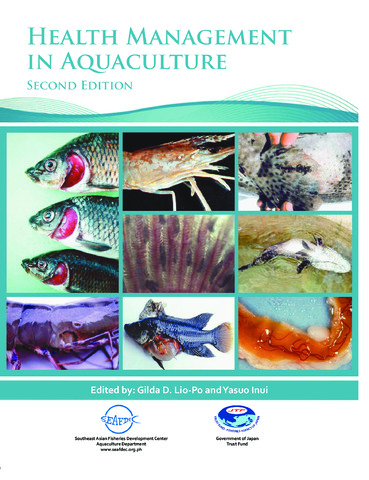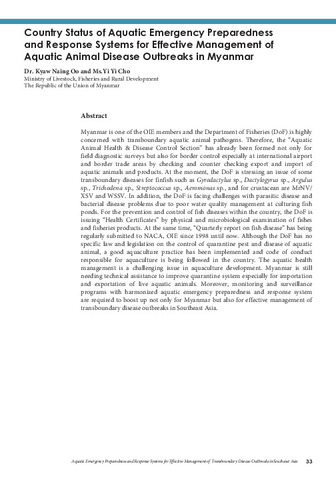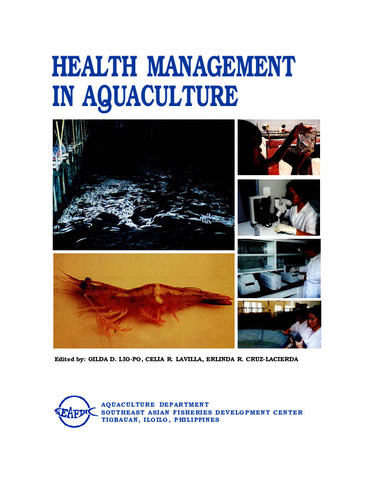| dc.contributor.author | Hirono, Ikuo | |
| dc.contributor.author | Tinwongger, Sasiwipa | |
| dc.contributor.author | Nochiri, Yuki | |
| dc.contributor.author | Kondo, Hidehiro | |
| dc.contributor.editor | Pakingking Jr., Rolando V. | |
| dc.contributor.editor | de Jesus-Ayson, Evelyn Grace T. | |
| dc.contributor.editor | Acosta, Belen O. | |
| dc.date.accessioned | 2016-12-06T07:55:41Z | |
| dc.date.available | 2016-12-06T07:55:41Z | |
| dc.date.issued | 2016 | |
| dc.identifier.citation | Hirono, I., Tinwongger, S., Nochiri, Y., & Kondo, H. (2016). Latest research on acute hepatopancreatic necrosis disease (AHPND) of penaeid shrimps. In R. V. Pakingking Jr., E. G. T. de Jesus-Ayson, & B. O. Acosta (Eds.), Addressing Acute Hepatopancreatic Necrosis Disease (AHPND) and Other Transboundary Diseases for Improved Aquatic Animal Health in Southeast Asia: Proceedings of the ASEAN Regional Technical Consultation on EMS/AHPND and Other Transboundary Diseases for Improved Aquatic Animal Health in Southeast Asia, 22-24 February 2016, Makati City, Philippines (pp. 3-10). Tigbauan, Iloilo, Philippines: Aquaculture Department, Southeast Asian Fisheries Development Center. | en |
| dc.identifier.isbn | 9789719931065 | |
| dc.identifier.uri | http://hdl.handle.net/10862/3082 | |
| dc.description.abstract | Acute hepatopancreatic necrosis disease (AHPND) is caused by unique strains of Vibrio parahaemolyticus (VPAHPND) and V. harveyi that have transferrable plasmid carrying the virulent PirAB-like toxin genes. The genomes of VPAHPND strains and V. harveyi from Thailand and Viet Nam, respectively, have been characterized by our group. The genome of VPAHPND strains from Mexico, Viet Nam, and China have also been studied by other groups. We have developed a conventional polymerase chain reaction (PCR) and loop-mediated isothermal amplification (LAMP) methods for the detection of AHPND using a primer set that targets the PirAB-like toxin genes of VPAHPND. We have characterized the toxin genes of VPAHPND strains and also constructed a recombinant plasmid (broad host range) carrying PirAB-like toxin genes. Non-VPAHPND strain N7 which does not carry the plasmid and strain FP11 which is carrying a plasmid not coding for the toxin genes were transformed with the plasmid carrying PirAB-like toxin genes. As a result, the transformed N7 and FP11 strains became virulent and killed whiteleg shrimp (Penaeus vannamei) similar to or at par with the virulence of VPAHPND strain. We then fed the whiteleg shrimp with commercial feed containing the formalin-killed VPAHPND strain. After 2 days of feeding, all of the whiteleg shrimp died. These results clearly indicate that the PirAB-like toxin is the virulence factor of VPAHPND.
We have been investigating the virulence mechanism of the PirAB-like toxin produced by VPAHPND strains. First, we calculated the copy number of plasmid encoding the PirAB-like toxin genes of several VPAHPND strains. The copy number of the plasmid varied, ranging from 1 to 36 copies. Interestingly, VPAHPND strains carrying low copy number of plasmid were more virulent than VPAHPND strains carrying high copy number of the plasmid. These results imply that the copy number of toxin genes is not an important factor responsible for the degree of virulence of the VPAHPND strains. We are also studying other factors associated with the virulence of PirAB-like toxin. Likewise, we are developing prevention methods against AHPND including the use of formalin-killed cell vaccine, IgY additive in feed, and nano-bubble treatment of rearing water. This paper summarizes the current R&D on the disease. | en |
| dc.language.iso | en | en |
| dc.publisher | Aquaculture Department, Southeast Asian Fisheries Development Center | en |
| dc.subject | Penaeidae | |
| dc.subject | Vibrio harveyi | |
| dc.subject | Vibrio parahaemolyticus | |
| dc.subject | Thailand | en |
| dc.subject | Viet Nam | en |
| dc.subject | China | en |
| dc.subject | Mexico | en |
| dc.title | Latest research on acute hepatopancreatic necrosis disease (AHPND) of penaeid shrimps | en |
| dc.type | Conference paper | en |
| dc.citation.spage | 3 | |
| dc.citation.epage | 10 | |
| dc.subject.asfa | bacterial diseases | en |
| dc.subject.asfa | fish diseases | en |
| dc.subject.asfa | genes | en |
| dc.subject.asfa | genomes | en |
| dc.subject.asfa | husbandry diseases | en |
| dc.subject.asfa | research | en |
| dc.subject.asfa | shrimp culture | en |
| dc.subject.asfa | microbiological strains | en |
| dc.subject.asfa | analytical techniques | en |
| dc.citation.conferenceTitle | Addressing Acute Hepatopancreatic Necrosis Disease (AHPND) and Other Transboundary Diseases for Improved Aquatic Animal Health in Southeast Asia: Proceedings of the ASEAN Regional Technical Consultation on EMS/AHPND and Other Transboundary Diseases for Improved Aquatic Animal Health in Southeast Asia, 22-24 February 2016, Makati City, Philippines | en |



